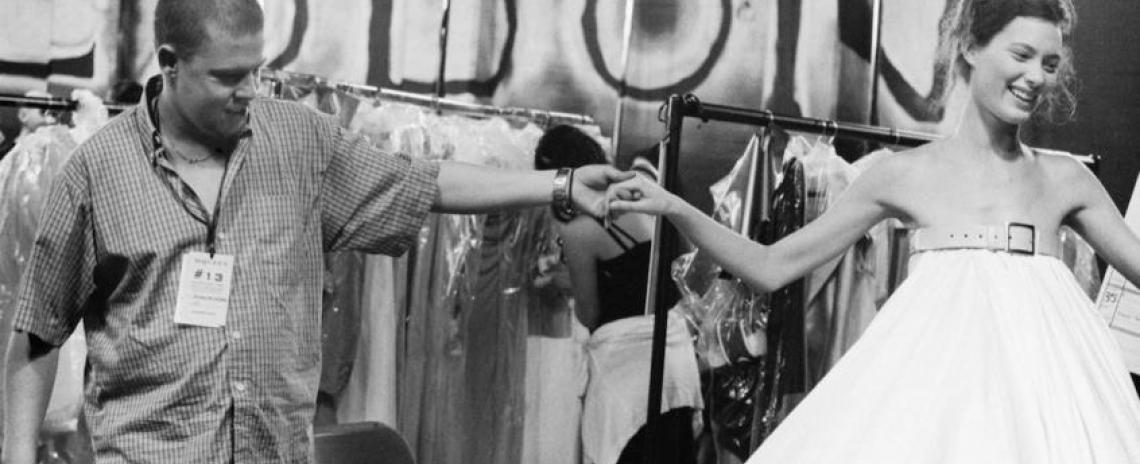For those already familiar with the well-publicized life and highly regarded work of Alexander McQueen, there’s nothing revelatory in Ian Bonhôte and Peter Ettedgui’s McQueen. The biographical documentary — that most popular of nonfiction subgenres — recounts the designer's meteoric rise from a young, ambitious, working-class tailor’s assistant to one of the most recognizable faces in high fashion. The film moves through the form’s familiar beats, illustrating how its subject achieved his dreams and then documenting the personal fallout that inevitably ensued when his cultural impact began to consume his identity. The way that the machinery of fame devours the most vibrant figures — the artists who struggle to resist celebrity’s pleasures and maintain their autonomy — is well-trodden territory in films of this ilk. While McQueen also investigates this system, the film’s chief value is in how it deftly sculpts a portrait of a now-deceased man and his passions, primarily through the lens of his work and those closest to him.
Mostly eschewing hagiography for more complex readings of McQueen’s work, the film mines the cultural import of his art through its subjects’ relationships to it, while also incorporating the designer’s singular aesthetic. McQueen makes an auteurist argument as it explores its subject’s work, showing how the designer’s marrying of contrasting elements — the baroque macabre, the chilly industrial, and a playfulness with gender norms and silhouettes — was borne from his worldview and remained consistent through his unfortunately brief career. Structured around five parcels of home-video footage filmed concurrently with five of McQueen’s most renowned shows, the documentary showcases how his work grew into extravagant theatrical productions, which were as much performance art as they were showcases for fashion.
The film posits that these shows and their individual designs emanated from the designer’s psyche, a place fraught with personal and political anxieties that eventually led McQueen to take his own life in 2010, on the eve of his mother’s funeral. As a celebration of that work, however, Bonhôte and Ettedgui’s film inspires awe not only by allowing the audacious work speak for itself, but also by integrating gothic, McQueen-inspired CGI to cohere the narrative around the artist’s personal expression. The documentary is scored by Michael Nyman (The Piano, Gattaca), a composer named-checked by McQueen in archival footage. All of these aesthetic qualities merge in one glorious wellspring of ecstasy that is the Summer 1999 show, with its legendary, show-stopping reveal of a belted tulle dress spray-painted by robotic arms.
Largely resisting the urge to trot out cultural critics to extol the virtues of the artist’s work, McQueen leaves such matters to the designer’s cohorts in the eponymous fashion house that Lee — as his friends and family called him — founded. Former assistant designer Sebastian Pons and stylist Mira Chai Hyde recall the verve with which their founder created his trademark looks, working quickly and furiously with bursts of creative inspiration. These two, along with many others, also explore the emotional rollercoaster they experienced when Lee took on a role as executive creative director at Givenchy and later Gucci, all while maintaining his own line. The stress from being the busiest and most scrutinized man in fashion — and being diagnosed with HIV — meant that Lee distanced himself from the people to whom he was closest. Instead, he threw himself into a life fueled by drugs and fitness, changing his former pudgy self into an unrecognizable muscle-bound man.
Although McQueen does not make its subject’s suicide clear from the outset, the interviewees’ reverence for the man and their regret-tinged tales imbue the film with a mournful quality. One of the more gut-wrenching interviews is with Detmar Blow, widower of Isabella Blow, the London fashionista who made McQueen a brand name and who would call him a soulmate. He recounts how the pair’s friendship quickly deteriorated when money — and lots of it — was introduced into the equation and the power differential ostracized Isabella from both the fashion community and Lee’s life.
These sections, paired with those of McQueen’s sister, Janet — whose friendship and loyalty seemed to have kept Lee afloat throughout his professional rise and personal fall — form the documentary’s thesis. Namely, the story of a life is as much about the the people who orbit an individual as it is about the actual individual. These heavy-handed passages co-exist alongside those about love, work, health, and all the other highs and lows that characterize the human experience. As a portrait of a specific community galvanized around a revolutionary artist, the film makes for one of the more exhaustive and exhilarating biodocs of recent years. As such, it deserves to be widely acknowledged alongside the likes of this year’s Won’t You Be My Neighbor? and RGB.
Rating: B


